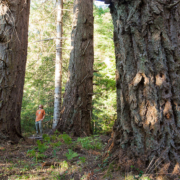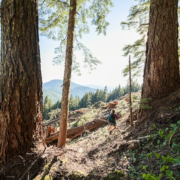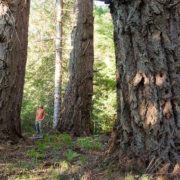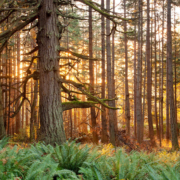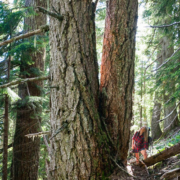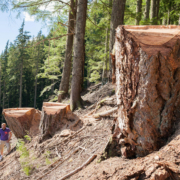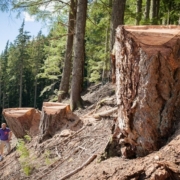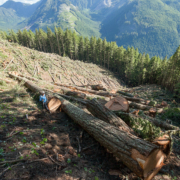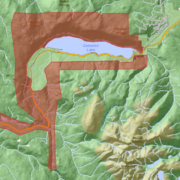Conservationists call on BC government to expand protection around Cathedral Grove, including Mount Horne, the scenic Cameron Lake, the Alberni Summit Highway, and the Cameron River Canyon, as Island Timberlands is poised to log Mount Horne above the world-famous old-growth forest.
Port Alberni, Vancouver Island – Conservationists are calling on the BC government to expand protection around MacMillan Provincial Park to fully encompass the forests above and adjacent to the world-famous Cathedral Grove. Cathedral Grove is Canada’s most popular old-growth forest on Vancouver Island, visited by millions of tourists each year, and is found in the 301 hectare MacMillan Provincial Park. Island Timberlands has built a road through old-growth forests on Mt. Horne, the mountainside above Cathedral Grove, and could potentially commence logging soon of a new cutblock that could come as close as 300 meters away from the park boundary.
The preliminary conservation vision, that must still undergo consultation and refinement, would expand protection around the currently protected lands of 740 hectares (301 hectares in Macmillan Provincial Park and the adjoining 440 hectare Little Qualicum Falls Provincial Park) by an additional 2900 hectares. See a map of the vision at: https://16.52.162.165/photos-media/
The proposed expansion through a new provincial conservancy would include the old-growth forests, mature second-growth forests, and some recovering clearcuts around the parks, including:
– Cathedral Grove’s surrounding forests: These are the forests on the mountainsides above MacMillan Park and the main highway, including Mount Horne which is threatened by Island Timberlands. See images of the Mount Horne forest at: https://16.52.162.165/photos-media/cathedral-grove-canyon/
– Highway Scenic Buffer: Forests west of the existing park that currently buffer the main highway (Highway 4) up to the Port Alberni Summit (locally nick-named “The Hump”) to preserve the scenic viewshed of the drive from Cathedral Grove to Port Alberni (including the view for millions of tourists heading towards Tofino).
A year ago, local Port Alberni residents fought Island Timberlands from expanding a massive clearcut that would’ve marred the view along the highway, forcing the company to back off (see https://www.timescolonist.com/news/local/island-timberlands-logging-of-alberni-summit-could-denude-the-hump-1.50473). Now it’s time to secure final protection for the highway’s forested buffer.
– Cathedral Grove Canyon: The spectacular old-growth forests and geological features of the area also known as the Cameron River Canyon, which should be a national treasure, were previously flagged for logging by Island Timberlands until a public outcry raised large-scale awareness. See photos at: https://16.52.162.165/protecting-old-growth-rainforests-to-the-economic-benefit-of-tourism-based-communities/4
– Cameron Lake: Cameron Lake is a highly scenic lake that millions of tourists drive alongside on Highway 4 before reaching Cathedral Grove. The Crown lands on the north side of the lake should be protected, as only a narrow strip along the south side of the lake is currently protected.
The lands would be a combination of unprotected Crown lands (about 1000 hectares) and private lands owned by Island Timberlands (about 1900 hectares) that would require funds from the BC government, other levels of government, and possibly private land trusts for their purchase.
Logging the mountainside above the park would cause increased erosion and siltation into the park, destroy vital old-growth forest wildlife habitat, and ruin scenery and recreational opportunities on the Mount Horne Trail. See a map of the cutblock at www.SaveCathedralGrove.com
“The Horne Mountain block above Cathedral Grove is an area that the BC government’s own scientists consider to be of high conservation value. They worked for years trying to have protections placed on it. Despite environmental concern and public interest, professional foresters of Island Timberlands seem to be moving ahead with their harvesting plans – roads have now been constructed through this intact old growth forest and logging could start soon. Unfortunately, it is hard to imagine that logging on Mt. Horne's steep slopes above Cathedral Grove will have no negative effect on this iconic forest's health and longevity,” stated Jane Morden, coordinator of the Port Alberni Watershed-Forest Alliance.
“Of all places where the BC government needs to show environmental leadership it’s in Canada’s most famous old-growth forest, Cathedral Grove,” stated Annette Tanner, Chairwoman of the Mid-Island Chapter of the Western Canada Wilderness Committee. “The public shouldn’t bear the endless responsibility of safeguarding the park’s ecological integrity from the repeated onslaught of logging threats on adjacent mountainsides above Cathedral Grove. Will the BC government step forward and show leadership to safeguard the ecological integrity for this world-famous ancient forest and expand protection around it?”
“After the redwoods of California, Cathedral Grove is the best known old-growth forest on Earth. It should be a first rate priority for the BC government to stop any logging plans that threaten the park’s ecological integrity and ancient forest that millions of people visit,” stated Ken Wu, Ancient Forest Alliance executive director. “The BC government deregulated the environmental protections on this land in 2004 and failed to follow-through on an agreement that was supposed to protect the old-growth forests on those lands. They broke it, now they have a responsibility to fix it. The expansion of protected areas around Cathedral Grove, the scenic highway, Cameron Lake, and the Cathedral Grove Canyon will make this a world-class protected area, both ecologically and for tourism.”
“We need the BC government to re-establish a BC Park Acquisition Fund to purchase and protect endangered old-growth forests on private lands, starting with Cathedral Grove – or re-regulate them. In the meantime, Island Timberlands needs to back off if they have any environmental and community conscience,” stated TJ Watt, Ancient Forest Alliance campaigner and photographer.
More Background Info
Cathedral Grove is within the 301 hectare MacMillan Provincial Park, an area smaller than Vancouver’s Stanley Park, located along the Cameron River at the base of Mount Horne where the planned logging would occur. In 1997 the postage-stamp-sized park saw roughly 10% of its largest trees blow down in a winter storm, exacerbated by clearcutting near the park’s edge.
The protected areas expansion is a preliminary vision, still in development, being proposed by the Ancient Forest Alliance and local conservationists.
The new roads and planned logging will have numerous detrimental effects, including: fragmenting the continuous forest cover and wildlife habitat on the slope above Cathedral Grove; destroying some of the last remaining 1% of BC’s old-growth Douglas-fir trees on BC's coast; destroying the wintering habitat of black-tailed deer in an area previously proposed for protection by BC government scientists to sustain them; likely increasing siltation into the Cameron River (which runs through Cathedral Grove) during the heavy winter rains as soil washes down from a new clearcut and logging road; and destroying part of the Mount Horne Loop Trail, a popular hiking and mushroom-picking trail that the cutblock overlaps.
• See the Times Colonist article (March, 2013) on the discovery of the company’s logging plans: https://www.timescolonist.com/news/local/old-growth-near-cathedral-grove-set-for-imminent-logging-activists-1.90194
• See the CHEK TV clip (March 2013) about the original cutblock discovery: https://www.youtube.com/watch?v=3exaYAqSrzw
Until recently many of these threatened areas were regulated to the stronger standards found on public lands. However, in 2004, the BC Liberal government removed 88,000 hectares of Weyerhaeuser’s private forest lands, now owned by Island Timberlands, from their Tree Farm Licences, thereby not implementing the planned old-growth, scenic, wildlife, and endangered species habitat protections on those lands, and removing the existing riparian protections and restrictions on raw log exports. A follow-up agreement with the corporate landowners was supposed to see the protection of many of the deregulated old-growth forests (ie. proposed Ungulate Winter Ranges for elk and deer, and species-at-risk Wildlife Habitat Areas), but Island Timberlands and the BC Liberal government broke off negotiations several years ago and have failed to continue pursuing a solution. Alberni-Pacific Rim Member of the Legislative Assembly (MLA) Scott Fraser has repeatedly worked to hold the BC government to account to remedy the situation by getting Island Timberlands to hold-off from logging these hotspots until a political solution can be implemented.
The flagged cutblock on Mount Horne by Island Timberlands is estimated to be about 40 hectares and lies on the southwest facing slope of the mountain on the ridge above the park and highway that millions of tourists visit annually. The logging would take place in an area formerly intended by BC government biologists to become an Ungulate Winter Range to protect the old-growth winter habitat of black-tailed deer – a designation that never came to fruition when the BC Liberal government deregulated the lands in 2004 by removing them from their Tree Farm Licence. Mt. Horne and the Cathedral Grove area is in the territorial boundaries of the Hupacasath and Qualicum peoples.
Island Timberlands is currently engaged in multiple logging incursions into other highly endangered old-growth forests besides Mount Horne. This includes recent logging and/or road-building in Kwakiutl First Nations territory near Port Hardy; on McLaughlin Ridge, Juniper Ridge, Labour Day Lake, and the Cameron Valley Firebreak in the Port Alberni area (see: https://16.52.162.165/news-item.php?ID=678); plans to log the Stillwater Bluffs near Powell River and the Day Road Forest near Roberts Creek on the Sunshine Coast; and plans to log old-growth forests near Basil Creek and the Green Valley on Cortes Island. See spectacular PHOTOS of most of these forests at: https://16.52.162.165/photos-media/
Island Timberlands (IT) is the second largest private land owner in BC, owning 258,000 hectares of private land mainly on Vancouver Island, the Sunshine Coast, and Haida Gwaii. Conservationists are calling on Island Timberlands to immediately back-off from its logging plans in old-growth and high conservation value forests until these lands can be protected either through purchase or through regulation.
Conservationists are also calling for a provincial plan to protect the province’s old-growth forests, to ensure sustainable second-growth forestry, and to end the export of raw, unprocessed logs to foreign mills. For private lands, conservationists are calling on the BC Liberal government to re-establish and bolster the former BC park acquisition fund (eliminated after the 2008 provincial budget). A dedicated provincial fund of $40 million per year (about 0.1% of the $40 billion annual provincial budget), raising $400 million over 10 years, would go a long way towards purchasing and protecting old-growth forests and other endangered ecosystems on private lands across the province. The fund would be similar to the existing park acquisition funds of various regional districts in BC, such as the $3 million/year Land Acquisition Fund of the Capital Regional District around Greater Victoria, which are augmented by the fundraising efforts of private citizens and land trusts.
BC’s old-growth forests are vital to support endangered species, tourism, the climate, clean water, wild salmon, and many First Nations cultures whose unceded lands these are. About 75% of the original, productive old-growth forests have already been logged on BC’s southern coast, including over 90% of the valley-bottom ancient forests where the largest trees grow, and 99% of the old-growth Douglas fir trees on BC's coast. See maps and stats at: https://16.52.162.165/ancient-forests/before-after-old-growth-maps/

